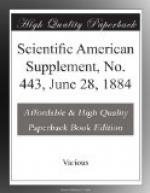Hon. T.S. Gold, of Connecticut, at a meeting of the Massachusetts State Board of Agriculture, in regard to preventing the ravages of the borer, said:
“A wash made of soap, tobacco water, and fresh cow manure mingled to the consistency of cream, and put on early with an old broom, and allowed to trickle down about the roots of the tree, has proved with me a very excellent preventive of the ravages of the borer, and a healthful wash for the trunk of the tree, much to be preferred to the application of lime or whitewash, which I have often seen applied, but which I am inclined to think is not as desirable an application as the potash, or the soda, as this mixture of soft soap and manure.”
J.B. Moore, of Concord, Mass., at the same meeting said, in regard to the destruction of the borer:
“I have found, I think, that whale oil soap can be used successfully for the destruction of that insect. It is a very simple thing; it will not hurt the tree if you put it on its full strength. You can take whale oil soap and dilute until it is about as thick as paint, and put a coating of it on the tree where the holes are, and I will bet you will never see a borer on that tree until the new crop comes. I feel certain of it, because I have done it.”
For borers, tarred paper 1 or 2 feet wide has been recommended to be wrapped about the base of the trunk of the tree, the lower edge being 1 or 2 inches below the surface of the soil. This prevents the two-striped borer from laying its eggs in the tree, but would not be entirely effectual against the flat-headed borer, which attacks any part of the trunk and the branches. By the general use of these means for the prevention of the ravages of the borers, the damages done by these insects could be brought within very narrow limits, and hundreds of valuable apple trees saved.
H. REYNOLDS, M.D.
Livermore Falls, Me.
* * * * *
KEFFEL’S GERMINATING APPARATUS.
The apparatus represented in the annexed cut is designed to show the quality of various commercial seeds, and make known any fraudulent adulterations that they may have undergone. It is based upon a direct observation, of the germination of the seeds to be studied.




